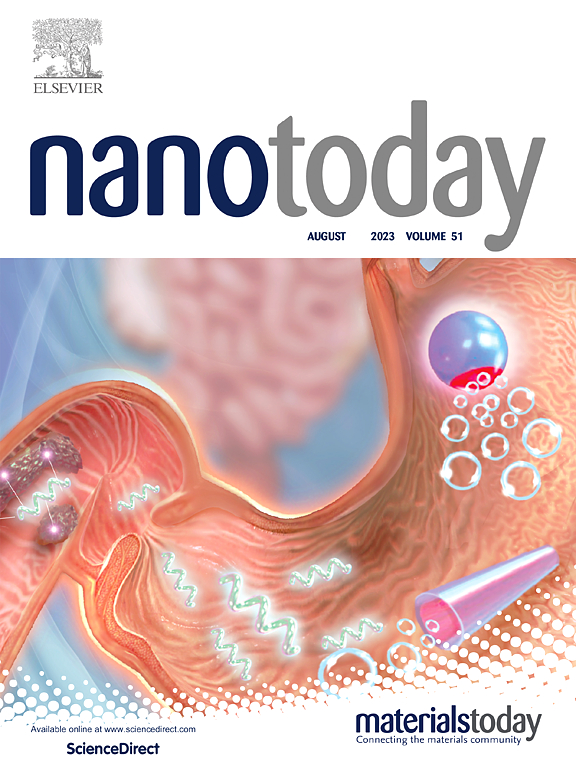通过前药复合物的自适应激活和微环境重塑来促进铜形体形成的综合治疗策略
IF 13.2
1区 材料科学
Q1 CHEMISTRY, MULTIDISCIPLINARY
引用次数: 0
摘要
结直肠癌(CRC)的进展是由其富含硫化氢(H₂S)的肿瘤微环境驱动的,该微环境通过稳定氧化还原稳态而促进免疫逃逸,从而矛盾地赋予化疗耐药。为了将这种脆弱性转化为治疗机会,我们开发了一种H₂S响应双前药系统(as - cu /DSF@TPP⁺),该系统利用内源性H₂S过表达作为生化触发器。该系统通过级联机制运行:(1)肿瘤特异性H₂S激活将无毒的As 5 +还原为细胞毒性的As³ +,破坏线粒体铜稳态,并通过脂化蛋白聚集启动铜还原;(2)释放的Cu 2 +与H₂S反应生成光热活性的硫化铜,实现局部热疗;(3)双硫仑衍生CuET建立了一个自扩增回路,同时通过CBS酶抑制消耗H₂S,放大铜积累。协同作用实现了双重治疗突破:通过线粒体铜过载和Fe-S簇不稳定的级联铜退化,加上免疫原性细胞死亡驱动的TME重塑,增强树突状细胞成熟和细胞毒性t细胞浸润。通过整合h2s清除、铜还原诱导和光热免疫疗法,该策略建立了一种“气体信号分子编程纳米疗法”范式。它不仅克服了crc特异性耐药机制,而且为靶向高H₂s恶性肿瘤提供了一个通用框架,展示了内源性肿瘤防御系统如何被重新利用为精确治疗武器。本文章由计算机程序翻译,如有差异,请以英文原文为准。
An integrated therapeutic strategy to enhance cuproptosis through adaptive activation and microenvironment remodeling of prodrug complexes
Colorectal cancer (CRC) progression is critically driven by its hydrogen sulfide (H₂S)-rich tumor microenvironment, which paradoxically confers chemoresistance by stabilizing redox homeostasis while promoting immune evasion. To transform this vulnerability into a therapeutic opportunity, we developed an H₂S-responsive dual prodrug system (As-Cu/DSF@TPP⁺) that leverages endogenous H₂S overexpression as a biochemical trigger. This system operates through a cascading mechanism: (1) Tumor-specific H₂S activation reduces nontoxic As⁵⁺ to cytotoxic As³ ⁺, disrupting mitochondrial copper homeostasis and initiating cuproptosis via lipoylated protein aggregation; (2) Released Cu²⁺ reacts with H₂S to generate photothermally active copper sulfide, enabling localized hyperthermia therapy; (3) Disulfiram-derived CuET establishes a self-amplifying loop, simultaneously depleting H₂S through CBS enzyme inhibition and amplifying copper accumulation. The coordinated action achieves dual therapeutic breakthroughs: cascading cuproptosis through mitochondrial copper overload and Fe-S cluster destabilization, coupled with immunogenic cell death-driven TME remodeling that enhances dendritic cell maturation and cytotoxic T-cell infiltration. By integrating H₂S scavenging, cuproptosis induction, and photothermal-immunotherapy, this strategy establishes a "gas signaling molecule-programmed nanotherapy" paradigm. It not only overcomes CRC-specific resistance mechanisms but also provides a universal framework for targeting H₂S-high malignancies, demonstrating how endogenous tumor defense systems can be repurposed into precision therapeutic weapons.
求助全文
通过发布文献求助,成功后即可免费获取论文全文。
去求助
来源期刊

Nano Today
工程技术-材料科学:综合
CiteScore
21.50
自引率
3.40%
发文量
305
审稿时长
40 days
期刊介绍:
Nano Today is a journal dedicated to publishing influential and innovative work in the field of nanoscience and technology. It covers a wide range of subject areas including biomaterials, materials chemistry, materials science, chemistry, bioengineering, biochemistry, genetics and molecular biology, engineering, and nanotechnology. The journal considers articles that inform readers about the latest research, breakthroughs, and topical issues in these fields. It provides comprehensive coverage through a mixture of peer-reviewed articles, research news, and information on key developments. Nano Today is abstracted and indexed in Science Citation Index, Ei Compendex, Embase, Scopus, and INSPEC.
 求助内容:
求助内容: 应助结果提醒方式:
应助结果提醒方式:


